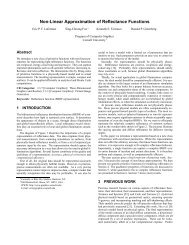pigmented colorants: dependence on media and time - Cornell ...
pigmented colorants: dependence on media and time - Cornell ...
pigmented colorants: dependence on media and time - Cornell ...
You also want an ePaper? Increase the reach of your titles
YUMPU automatically turns print PDFs into web optimized ePapers that Google loves.
Note that the sample can be a mixture of pigments, in which case Duncan’s K-M<br />
linear <str<strong>on</strong>g>pigmented</str<strong>on</strong>g> mixing from Equati<strong>on</strong> A.16 would be substituted with respective<br />
weighting.<br />
In order to analyze the data in terms of hue shift in a color-matching program,<br />
Johnst<strong>on</strong> suggests calibrati<strong>on</strong> with at least a three color pigment basis plus white,<br />
<strong>and</strong> the use of Duncan’s <str<strong>on</strong>g>pigmented</str<strong>on</strong>g> mixing equati<strong>on</strong>. One selects the hues of the<br />
pigments to ensure coverage over the entire gamut of colors (typically this selecti<strong>on</strong><br />
mimics the opp<strong>on</strong>ent color channels, choosing white, black, red or green, <strong>and</strong> yellow<br />
or blue). In this way, widely varying temporal changes (such as fading, darkening,<br />
<strong>and</strong> hue changes) can all be detected <strong>and</strong> recorded effectively [JFFBC84]. By<br />
means of Munsell notati<strong>on</strong> <strong>and</strong> color difference calculati<strong>on</strong>s, the work found that<br />
orderly changes in c<strong>on</strong>centrati<strong>on</strong> related to a n<strong>on</strong>linear change in the perceived<br />
color of a paint.<br />
Whitmore <strong>and</strong> Bailie presented a model predicting <strong>and</strong> verifying experimen-<br />
tally the loss from fading from two perspectives: in terms of colorant loss from<br />
photochemical reacti<strong>on</strong> <strong>and</strong> the resulting perceptual color changes [WB97]. The<br />
work determined that colorant loss takes place at three distinct stages. The dark-<br />
est (or most c<strong>on</strong>centrated) glazes lose colorant at the maximum (linear) rate, yet<br />
the color change is slight because there is little spectral change. Usually, ‘fading’<br />
for these glazes includes a shift in hue, followed by an increase in chroma. This is<br />
due to reflectance changes away from the absorpti<strong>on</strong> peak.<br />
As colorant is further lost, the absorbed wavelengths are less highly absorbent,<br />
hence the colorant loss slows. However, the magnitude of the perceptual color<br />
change increases (this is what is known as typical fading, with the chroma decreas-<br />
127<br />
ing <strong>and</strong> value increasing). Glazes having an inter<strong>media</strong>te reflectance (20 − 80%



